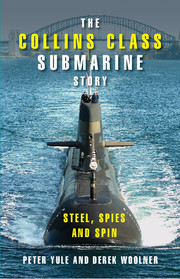Book contents
- Frontmatter
- Contents
- List of key people
- List of acronyms
- Introduction
- Part 1 You Can't Build Submarines in Australia
- Part 2 The Honeymoon Years 1987–92
- Part 3 ‘A Strange Sense of Unease” 1993–98
- Part 4 Resolution
- 22 ‘Hardly a day went by without the project getting a hammering in the press’: the project in crisis 1997–98
- 23 ‘Bayoneting the wounded’: the McIntosh-Prescott report
- 24 ‘That villain Briggs’ and the submarine ‘get-well’ program
- 25 ‘Inside the American tent’: the saga of the replacement combat system
- 26 ‘We'll do it and get rid of the buggers’: Kockums, ASC and Electric Boat
- 27 ‘We would find that challenging’: comparison and retrospect
- Notes
- Index
27 - ‘We would find that challenging’: comparison and retrospect
Published online by Cambridge University Press: 05 September 2013
- Frontmatter
- Contents
- List of key people
- List of acronyms
- Introduction
- Part 1 You Can't Build Submarines in Australia
- Part 2 The Honeymoon Years 1987–92
- Part 3 ‘A Strange Sense of Unease” 1993–98
- Part 4 Resolution
- 22 ‘Hardly a day went by without the project getting a hammering in the press’: the project in crisis 1997–98
- 23 ‘Bayoneting the wounded’: the McIntosh-Prescott report
- 24 ‘That villain Briggs’ and the submarine ‘get-well’ program
- 25 ‘Inside the American tent’: the saga of the replacement combat system
- 26 ‘We'll do it and get rid of the buggers’: Kockums, ASC and Electric Boat
- 27 ‘We would find that challenging’: comparison and retrospect
- Notes
- Index
Summary
In the early stages of the new submarine project Oscar Hughes was talking to a senior American admiral and outlined the aims and ambitions for the project. The American raised his eyebrows and said: ‘We would find that challenging.’
Building submarines is hard, and getting harder. To build a hull to withstand extreme water pressures has always been demanding, but the increasing complexities of electronics and computer systems make modern submarines among the greatest of engineering challenges. Even countries with long histories of submarine construction often have problems, while countries attempting to build submarines for the first time regularly experience disasters. Dilapidated or abandoned shipyards from Buenos Aires to Bombay littered with the relics of failed submarine projects testify to the magnitude of the challenges.
Electric Boat is the world's most experienced submarine builder, yet in the 1970s and early 1980s the building program for the Los Angeles class submarines was such a disaster the company was only saved by vast injections of government money. The story of the project's innumerable problems was chronicled in Running critical, Patrick Tyler's masterpiece of investigatory journalism. The hulls of several boats had to be ripped apart and then welded together again when it was found that thousands of welds were either missing or defective and many more had been improperly certified.
- Type
- Chapter
- Information
- The Collins Class Submarine StorySteel, Spies and Spin, pp. 319 - 329Publisher: Cambridge University PressPrint publication year: 2008



